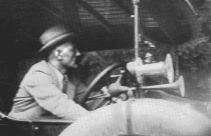
Gurdjieff International Review
Editorial
Working with Others
For most of the twentieth century, many people—including philosophers, psychologists, writers, and artists—have been influenced by Gurdjieff’s ideas. Most acknowledge this without posing as a source of his teaching. The situation is complicated by the growing number of individuals and organizations that find it convenient to borrow and adapt sometimes powerful ideas and practices from the Gurdjieff legacy for their own philosophical, psychological, or commercial purposes—sometimes claiming to offer a new dispensation that supersedes what Gurdjieff taught.
The burgeoning schools of enneagram analysis are an example of where a single diagram is taken from Gurdjieff, but everything else is the innovation of authors who present the enneagram as a classification system for personality analysis. The resulting speculation is unconnected with Gurdjieff’s ideas and teaching. The same situation arises when variations and imitations of Gurdjieff’s “movements” or “sacred dances” are demonstrated as musical calisthenics.
Real teachings inevitably generate such deflections, imitations, and distortions.
That someone mentions Gurdjieff, discusses his ideas at length, or personally knew him offers the sincere seeker no guarantee of substance. Conversely, although they do not mention him, books such as Maurice Nicoll’s New Testament exegesis The New Man, and René Daumal’s unfinished allegorical novel Mount Analogue, are highly valued by students of Gurdjieff because these compelling works of literature are profoundly rooted in his legacy.
Valuable clarification of these points can be found in Henri Tracol’s essay “Let Us Not Conclude,”1 in Dr. M. de Salzmann’s essay “Footnote to the Gurdjieff Literature,”2 and in the excerpt contained within this issue titled “People Who Hunger and Thirst for Truth.”3
Thanks to the readers who made valuable contributions in shaping this page and wish to remain anonymous.
Walter Driscoll
Greg Loy
~ • ~
1 First English publication in Gurdjieff: Essays and Reflections on the Man and His Teaching edited by Jacob Needleman, George Baker, and Mary Stein from the French edition compiled by Bruno de Panafieu. New York: Continuum, 1996, pp. 427–430. Reprinted in the Gurdjieff International Review, Vol. III (1), Fall 1999.2 First English publication in Parabola. New York: Vol. V (3), Summer, 1980 and revised in Gurdjieff: an annotated bibliography compiled by J. Walter Driscoll and the Gurdjieff Foundation of California. New York: Garland, 1985, pp. xv–xxv.
3 Views from the Real World: Early Talks of Gurdjieff, pp. 50–58.
|
This webpage © 2000 Gurdjieff Electronic Publishing Featured: Fall 2000 Issue, Vol. IV (1) Revision: October 1, 2000 |